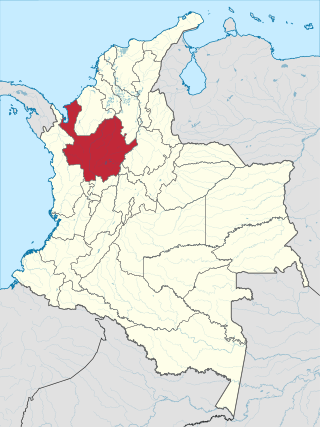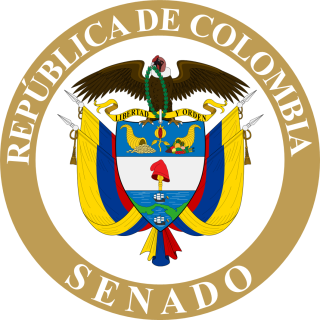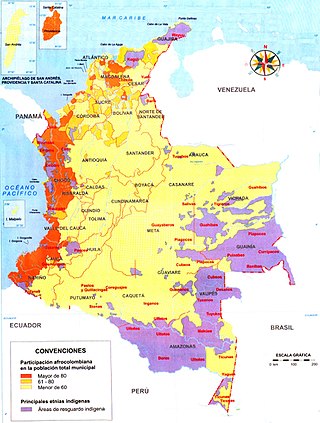Related Research Articles

Colombia, officially the Republic of Colombia, is a country in South America with insular regions in North America—near Nicaragua's Caribbean coast—as well as in the Pacific Ocean. The Colombian mainland is bordered by the Caribbean Sea to the north, Venezuela to the east and northeast, Brazil to the southeast, Ecuador and Peru to the south and southwest, the Pacific Ocean to the west, and Panama to the northwest. Colombia is divided into 32 departments. The Capital District of Bogotá is also the country's largest city. It covers an area of 1,141,748 square kilometers, and has a population of around 52 million. Colombia's cultural heritage—including language, religion, cuisine, and art—reflects its history as a Spanish colony, fusing cultural elements brought by immigration from Europe and the Middle East, with those brought by enslaved Africans, as well as with those of the various Indigenous civilizations that predate colonization. Spanish is the official state language, although English and 64 other languages are recognized regional languages.

The Government of Colombia is a republic with separation of powers into executive, judicial and legislative branches. Its legislature has a congress, its judiciary has a supreme court, and its executive branch has a president.

Antioquia is one of the 32 departments of Colombia, located in the central Northwestern part of Colombia with a narrow section that borders the Caribbean Sea. Most of its territory is mountainous with some valleys, much of which is part of the Andes mountain range. Antioquia has been part of many territorial divisions of former countries created within the present-day territory of Colombia. Prior to adoption of the Colombian Constitution of 1886, Antioquia State had its own sovereign government.
Cumbia refers to a number of musical rhythms and folk dance traditions of Latin America, generally involving musical and cultural elements from American Indigenous peoples, enslaved Africans during colonial times, and Europeans.

Colombia is a unitary republic made up of thirty-two departments and a Capital District. Each department has a governor (gobernador) and an Assembly, elected by popular vote for a four-year period. The governor cannot be re-elected in consecutive periods. Departments are country subdivisions and are granted a certain degree of autonomy.

The Cariban languages are a family of languages indigenous to northeastern South America. They are widespread across northernmost South America, from the mouth of the Amazon River to the Colombian Andes, and they are also spoken in small pockets of central Brazil. The languages of the Cariban family are relatively closely related. There are about three dozen, but most are spoken only by a few hundred people. Macushi is the only language among them with numerous speakers, estimated at 30,000. The Cariban family is well known among linguists partly because one language in the family—Hixkaryana—

The Senate of the Republic of Colombia is the upper house of the Congress of Colombia, with the lower house being the House of Representatives. The Senate has 108 members elected for concurrent (non-rotating) four-year terms.

Mitú is the capital town of the department of Vaupés in Colombia. It is a small town located in South eastern Colombia in the Amazon Basin. Founded in 1936, Mitú lies next to the Vaupés River at 180 meters above sea level. It is where the core of the services are provided to the Vaupés Department.

The Indigenous Authorities of Colombia is a progressive indigenist political party in Colombia.

Indigenous peoples of Colombia, are the ethnic groups who have inhabited Colombia since before the European colonization, in the early 16th century. According to the last census, they comprise 4.4% of the country's population, belonging to 115 different tribes.
Chester Allen "Chet" Bitterman III was an American linguist and Christian missionary who was kidnapped and killed by revolutionaries of the 19th of April Movement (M-19) in Colombia in 1981.

La Guajira is a department of Colombia. It occupies most of the Guajira Peninsula in the northeast region of the country, on the Caribbean Sea and bordering Venezuela, at the northernmost tip of South America. The capital city of the department is Riohacha.

Colombians are people identified with the country of Colombia. This connection may be residential, legal, historical or cultural. For most Colombians, several of these connections exist and are collectively the source of their being Colombian.

The National Indigenous Organization of Colombia is an organization representing the Indigenous peoples of Colombia, who, according to the 2018 census, comprise some 1,905,617 people or approximately 3.7% of the population. The organization was founded at the first National Indigenous Congress in 1982.
Afro-Colombians or African-Colombians are Colombians of full or partial sub-Saharan African descent.
Tinigua are the indigenous people who inhabited the river basin Yari, Caguan and today Caquetá Department of Colombia. In their language, Tinigua refers to the ancestors: tini probably meant “word of the ancients.”

Carijona (Karihona) is a Cariban language, or probably a pair of languages, of Colombia. Derbyshire (1999) lists the varieties Hianacoto-Umaua and Carijona proper as separate languages.

An indigenous territory in Colombia is an area of land reserved for use of the indigenous peoples of Colombia. Almost one third of the country is covered by these territories, although the indigenous people account for just over 3% of the population.
The Cabildo Mayor del Pueblo Muisca is an organisation of indigenous people, in particular the Muisca. It was established in September 2002 in Bosa, Bogotá, Colombia. The organisation, member of National Indigenous Organization of Colombia (ONIC), focuses on defending the rights of the descendants of the Muisca, and the development of cultural and historical heritage, territory and health and the linguistics of the indigenous language, Muysccubun.
The Taranoan languages are a subgroup of the Cariban language family. The languages are spoken in Brazil, Suriname, and Colombia.
References
- ↑ Ethnologue
- ↑ Database for Indigenous Cultural Evolution Archived April 21, 2015, at the Wayback Machine
- ↑ Colombia Natural Parks, pg 392